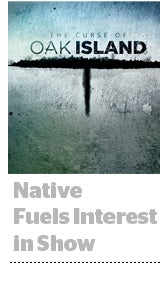 Horizon Media had done plenty of direct-to-publisher native campaigns to promote shows for its entertainment clients, including The History Channel.
Horizon Media had done plenty of direct-to-publisher native campaigns to promote shows for its entertainment clients, including The History Channel.
But the campaigns lacked scale.
“Curating these experiences in a way where we can impact scale is vitally important when we’re trying to drive a [Nielsen] ratings number,” said Joe Hadari, SVP and managing director of Horizon Media.
When running native programs curated directly with a publisher, Horizon faced “diminishing returns for how able we were to scale,” Hadari said.
With that in mind, Horizon devised a plan to promote the second season of The History Channel’s reality series, “The Curse of Oak Island,” that involved creating content to be distributed across Nativo’s publisher network, including sites like Perez Hilton, the Examiner and IFL Science. The campaign ran from October to February, both in the lead up to the premiere and throughout the season.
By using the publisher network, Horizon could distribute its content widely without countless man hours devoted to optimization. Because the campaign was native, Horizon expected higher engagement – and the campaign delivered.
“The time spent on content averaged over two minutes, when a pre-roll spot is 15 or 30 seconds,” Hadari said. “That was a strong consumer connection, and that engagement metric was most meaningful for us.”
The content also boasted a click-through rate of 1.99%.
Because The History Channel is already a content creator, it prefers opportunities to showcase its own content, rather than slapping its name on someone else’s product. That made Nativo, which focuses on distribution of content, a better fit than going to a publisher’s content studio.
“What we like about native is it capitalizes on partners’ environments, and allows us to integrate in a really organic way across publishers,” Hadari said. “We didn’t want it to feel inauthentic when we expanded the native offering.”
Nativo’s optimization algorithm will optimize toward the content that works best within a publisher’s site, addressing that issue of authenticity.
“We ran 50 versions with different permutations of imagery, headlines and content,” Hadari said, noting that Nativo’s tech optimized to match the best creative to the best environment.
In this campaign, the same type of content rose to the top no matter the environment. Readers engaged most with content that emphasized the themes of the show, namely mystery.
“It was good to prove out that you don’t need to be as explicit about what you’re saying” vs. a brand display ad, for example, where tune-in messaging needs to be more clear-cut, Hadari said.
The native placements functioned as the top-of-funnel part of the campaign, while video pre-roll further raised awareness. Retargeting reached readers who had viewed the content to remind them of their interest in the show.
The Publisher Point Of View
Over the course of the “Curse of Oak Island” campaign, Nativo moved placements to top-performing sites while also optimizing within them. For the Examiner, one of the top-performing sites in the campaign, that led to a 2x increase in time spent and a 6x increase in successful calls to action – for example, clicking “Watch now.”
The Examiner has been working with Nativo since the fall, and it welcomes the revenue that comes from Nativo advertisers. As VP of revenue operations for the Examiner, Julie Butler looks for “advertising opportunities that are high-quality, that our users will like and [that] will bring in high CPMs.”
Nativo, the first native provider the Examiner has worked with, fit those criteria. The publisher typically sees about 30 campaigns running through Nativo’s marketplace at a given time. Advertisers pay Nativo on a viewable CPM and publishers receive payment on the same basis.
To better attract readers, the Examiner experimented with different placements for the native ad units. Discovering that the bottom of the page performed poorly, the publisher now focuses on putting units at the top of the page, such as in the right rail – a placement that’s not in-feed, per se, but mirrors the look of articles.
“[Readers] seem happy with well-integrated visuals vs. invasive banners,” Butler said.
That’s what Horizon is trying to achieve, too.
“With native, it’s beneficial to the publisher and advertiser to make it more relevant to the consumers,” Hadari said.
The challenge for publishers, however, will be to scale native “in a tempered way to make sure they’re maintaining the value of their product in the native space,” he added.












